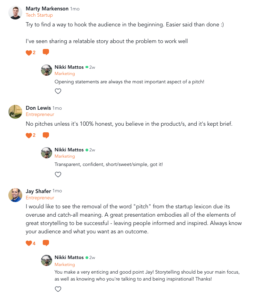
Different Perspectives on What Makes a Good Pitch
It’s always nerve-racking having to pitch your ideas to investors and can be a make-it or break-it moment for many startups. That’s why being prepared should take priority every time you decide to pitch! Of course, there are the “recommended standards” like Guy Kawasaki’s, “The Only 10 Slides You Need in Your Pitch,” or Harvard Business Review’s “What Makes a Great Pitch”, and although both are extremely helpful, neither of them quite cover what investors and business partners actually want to see from you. Here at VCET, we’ve gathered a collection of perspectives from a diverse range of investors and entrepreneurs who can, with confidence, tell you what you need to know in order to nail your next pitch!
Dave Bradbury, VCET President:
Dave continues to explain, “one of the biggest mistakes you can make is looking lazy. For example, using a cheap piece of clip art, or numbers that don’t match. On one slide you might be talking about one particular market size, and on the other, you could be talking about a completely different market size. That not only confuses me but it also says that you don’t completely understand your own business. However, you can be simple without looking lazy. Meaning when you’re presenting your pitch deck, try making one big point per slide, and if your recipient, investor, or partner is interested they can either look at footnotes or can ask you to elaborate.
Always remember that entrepreneurs and founders are taking a risk and it can get very tense – to the point where they can’t express themselves very well. That’s when we say “hey just unplug the screen, tell us about yourself, how’d you get here?” We try to get back to the basics in order to understand the human, understand the entrepreneur, and why they think this business is the one. A formal pitch can sometimes seem out of reach. Founders don’t always come from a place where they’re comfortable presenting, or the terminology can seem very foreign! That doesn’t mean they aren’t creative or experts in technology, it’s just a language that they’re unfamiliar with. I love what we do here at VCET- we encourage newcomers to come as they are, show us what you got, what you want, and we’re never going to prejudice our view of you just from one or two meetings!”
Skylar Bagdon, Head of Business Development at PanicMechanic/Head of ARC Program at UVM:
Skylar further elaborates, “be aware of your audience! Check people out on LinkedIn, and get to know their values and what they care about. If your visions align and you can create value for them, they can then offer an exchange of whatever resources or funds they have for a value that’s meaningful to them. Maybe that’s strictly financial return but often, at least in the projects I’ve been involved in, it’s not. People care about something broader and if they prefer to have that value over money that they currently already have then you’re providing something meaningful in return.
One last thing is to be energetic and passionate, even if that’s not your personality. You can have a terrible idea and no one might understand what you’re trying to say, but if you present with a lot of enthusiasm and excitement, there will be people who will feel excited for you! I used to work teaching a class about lead paint regulation to contractors, and it was the most boring thing ever but I was very energetic about it and I tailored it towards something they might care about like not poisoning young children, and I think it drastically helped! Bring the energy, bring the fire!”
Adam Polonski “Apolon”, Co-Founder of Lost Lantern:
Apolon clarifies, “be confident, while also being realistic. The most important thing to understand is knowing where investors are coming from. They don’t expect the numbers that you are presenting to necessarily reflect where you’re going to be. They’re buying your idea and the vision for your project, not the projections. My natural instinct is to always be cautious and reserved and to always give people the most conservative estimate. We’ve had to rethink that – we’re 99% sure we can reach a certain trajectory but reiterating the fact that it’s achievable and a better outcome than other trajectories. I’ve had to get comfortable with saying ‘here’s one of the best outcomes we can get, but we’re really confident we can get there, it’s realistic and achievable but does not necessarily undervalue your goals. At the end of the day, your pitch should never be matter-of-fact, it should tell a story.”
Here are a couple of tips from the Vermont Start-Up Collective:
Lastly, some outside resources from investor and active member of the Vermont Startup Collective Paul Silva:
Investor Pitch Template & Tips by Paul G. Silva:
Startup Pitching Checklist by Paul G. Silva:
10 Commandments for Great Startup Pitches by Slidebean:
[arve url=”https://www.youtube.com/watch?v=T40sSdhebsY” loop=”no” muted=”no” /]
Given the enthusiastic and helpful advice from both sides of the spectrum, we’d say your team is more than ready to pitch! Remember to bring passion and focus on telling your story! Be authentic and don’t psych yourself out, because when one door closes another one opens. Practice makes perfect and there’s nothing more encouraging than hearing tips and tricks straight from the source! We know that good ideas take shape in community, and there is nothing better than learning from the tested advice of investors, innovators, and entrepreneurs taking ideas to new heights right here in Vermont.
If you’re interested in becoming part of our community or receiving free advising, reach out to us at info@vcet.co!
Published and edited by VCET Marketing Associate, Nicole Mattos-Parodi.




